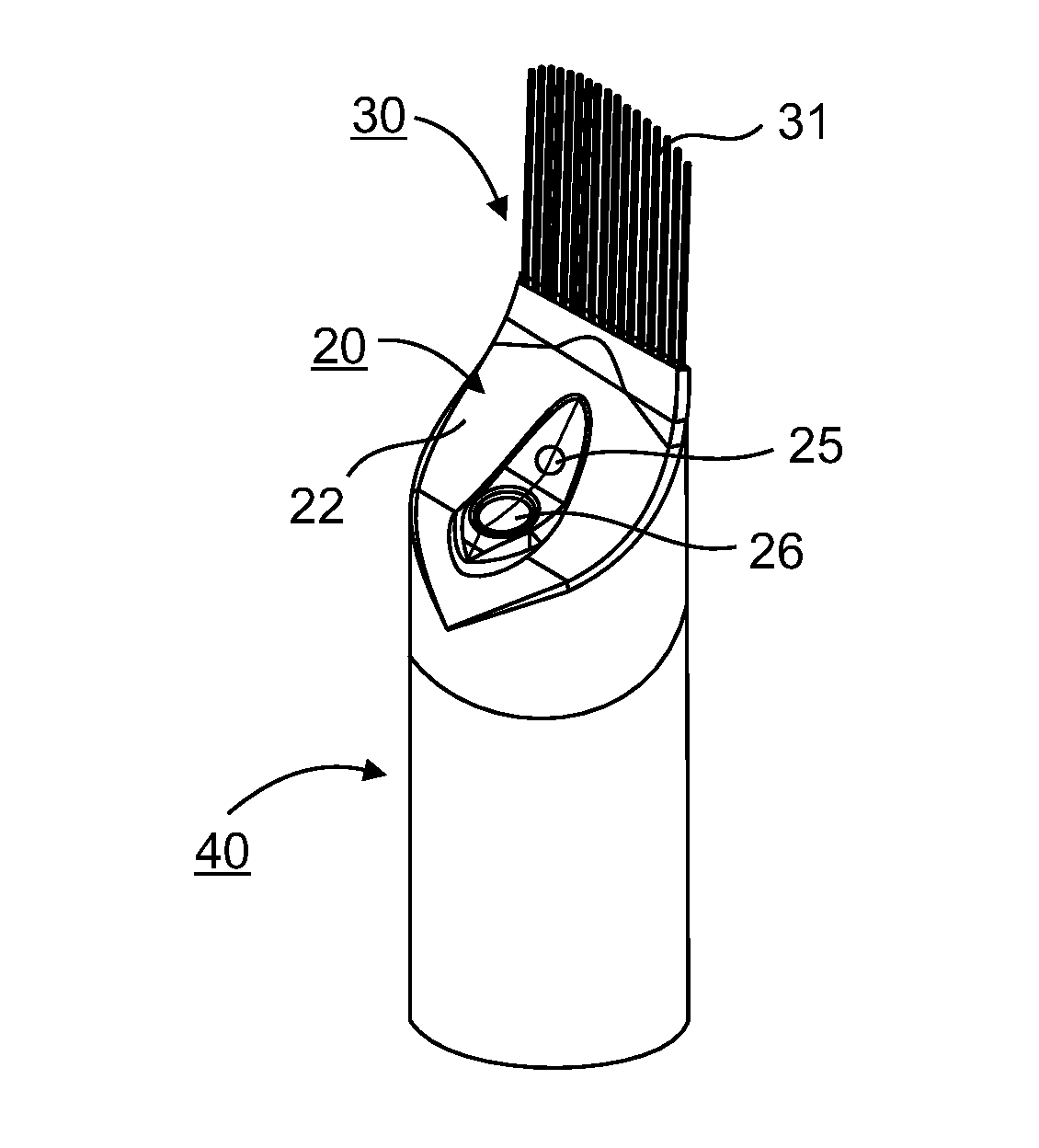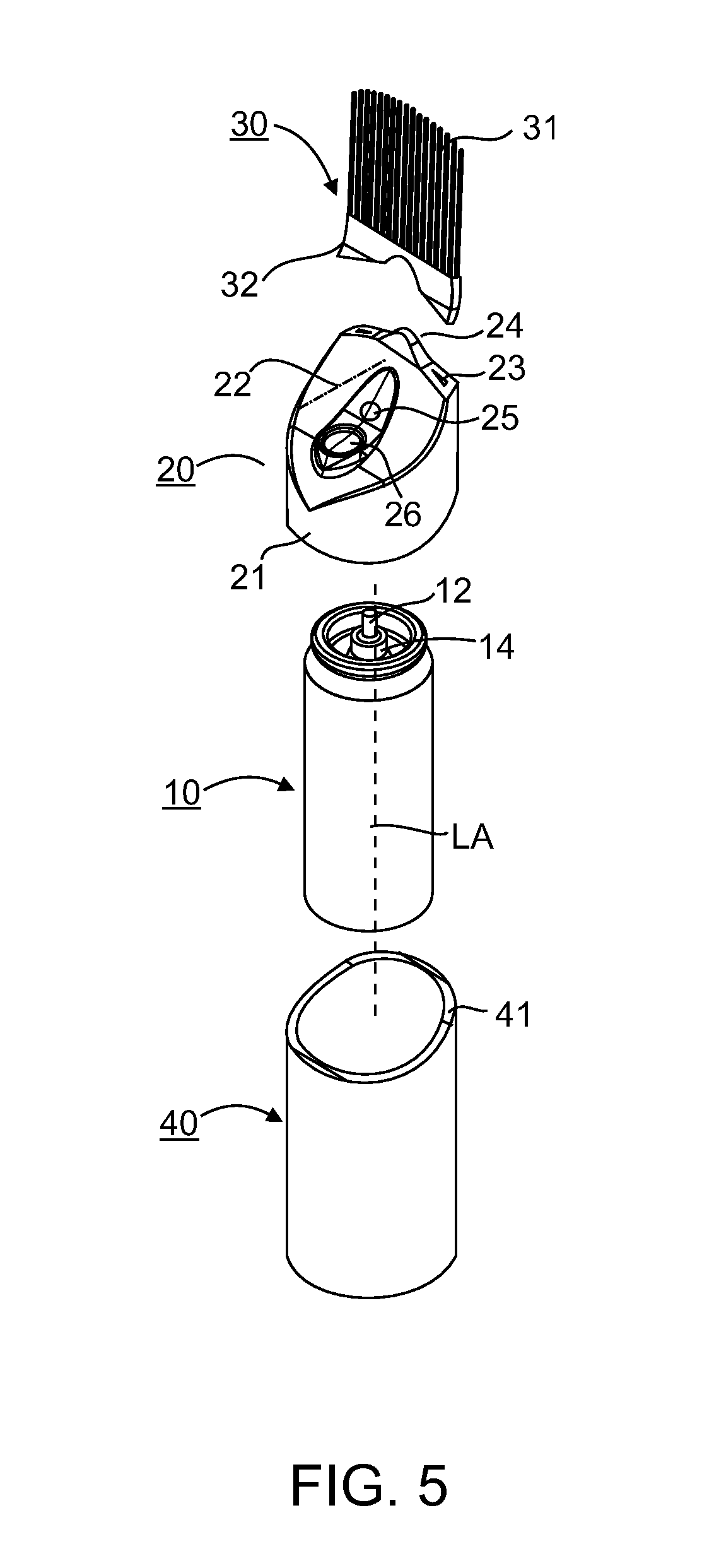Agents, compositions and devices for temporary coloring local hair areas
a technology for temporary coloring and hair, applied in hair cosmetics, packaging foodstuffs, packaged goods, etc., can solve the problems of not being able to hide the original hair color, using potentially harmful reagents, and complex mixing and application of precursors
- Summary
- Abstract
- Description
- Claims
- Application Information
AI Technical Summary
Benefits of technology
Problems solved by technology
Method used
Image
Examples
example 1
Preparation of Iron Tannate Hair Coloring Agent
[0317]Fifty (50) grams of tannic acid (Mallinckrodt, Catalog No. 1764) dissolved in 100 mL of water were mixed with 5 grams of ferric ammonium citrate (Sigma, Catalog No. F-5879) dissolved in 35 mL of water. The mixture was stirred at room temperature for 24 hours, and then purified.
[0318]The reaction mixture was purified by being loaded onto a Sephadex-G-25M column (Ø30×140 mm), pre-washed with 300 mL of water. 150-mL fractions were collected by eluting with water. After elution of the first five fractions containing a polymeric substance of saturated black color, the eluted fractions became almost colorless, implying exhaustive separation. The collected fractions did not give a positive test for unbound ferric (iron III) ions (see description hereinbelow). The water was evaporated by freeze-drying, providing a black powder as product I.
[0319]Alternatively, the reaction mixture was purified using ultrafiltration. The mixture was dilute...
example 2
Preparation of Melanoidin Condensation Polymer
[0327]Thirty (30) grams of L-glycine (Sigma, Catalog No. 7126) and 30 grams of D-glucose (J. T. Baker, Catalog No. 0114) were dissolved together in 110 mL of water, and the obtained solution was evaporated under reduced pressure. The residue was heated at 125° C. for 2.5 hours, during which the white mass became brown, with some foaming. The cooled reaction mixture was re-dissolved in water (180 mL), and 50 mL portions of the solution were purified on Sephadex-S25W columns (Ø30×180 mm), each pre-washed with 330 mL of water. The fractions eluted from each column with 110 mL of water were collected, combined, and evaporated, providing bright brown powder as product II.
example 3
Preparation of Two-Dye Hair Coloring Compositions
[0328]Aqueous stock solutions of products I and II were prepared, each at a concentrations of 0.05 gram / mL. Mixed solutions were prepared by blending the stock solutions in volume ratios of 1:4, 1:2, 1:1, 2:1, and 4:1.
[0329]Tresses of yak hair were dyed with the mixed solutions for 1 minute intervals, then blotted with paper and dried with a hair dryer. The tresses were darker than their original color, with shades varying from red-brown to black from mix to mix (see, Table 2).
[0330]The color of the dyed hair was partially lost after the hair was rinsed with water, and completely lost after the hair was shampooed.
[0331]
TABLE 2Treatment dye mixtureNo.I / IIVisual color11:4Red-brown21:2Reddish-brown31:1Brown42:1Brownish-black54:1Black
[0332]Thus, a weight ratio of the purified iron-tannate polymer and melanoidin described hereinabove which ranges from 1 part purified iron-tannate polymer to 10 parts melanoidin to 1 part purified iron-tanna...
PUM
 Login to View More
Login to View More Abstract
Description
Claims
Application Information
 Login to View More
Login to View More - R&D
- Intellectual Property
- Life Sciences
- Materials
- Tech Scout
- Unparalleled Data Quality
- Higher Quality Content
- 60% Fewer Hallucinations
Browse by: Latest US Patents, China's latest patents, Technical Efficacy Thesaurus, Application Domain, Technology Topic, Popular Technical Reports.
© 2025 PatSnap. All rights reserved.Legal|Privacy policy|Modern Slavery Act Transparency Statement|Sitemap|About US| Contact US: help@patsnap.com



